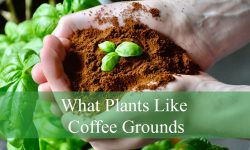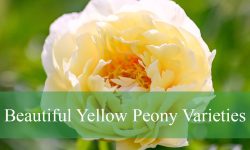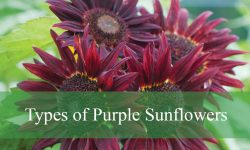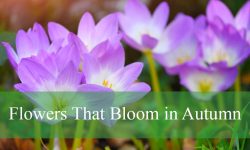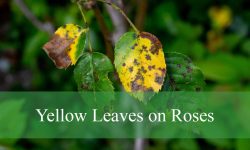If you’re like me, someone who’s spent years tending tropical gardens, you know that yellow hibiscus varieties bring a special kind of sunshine to any landscape. Their vibrant, cheerful blooms brighten up garden beds, patios, and containers, creating a warm and inviting atmosphere. Planting yellow hibiscus adds a striking splash of color and tropical flair that’s hard to beat.
Over the years, I’ve worked with many hibiscus types, and the yellow varieties stand out for their range of shades—from soft buttery yellows to bold golden hues. Each type has its own unique charm, flower shape, and growth habit, making them versatile choices for different garden styles and climates. Understanding these differences helps in selecting the perfect hibiscus to match your space and care routine.
This guide introduces 15 of the most beautiful yellow hibiscus varieties, complete with pictures and growing tips. For gardeners new and experienced alike, these tropical beauties offer inspiration and reliable options to bring golden sunshine into your garden all year round.
Best Yellow Hibiscus Varieties for Your Garden
Sunny Wind Hibiscus
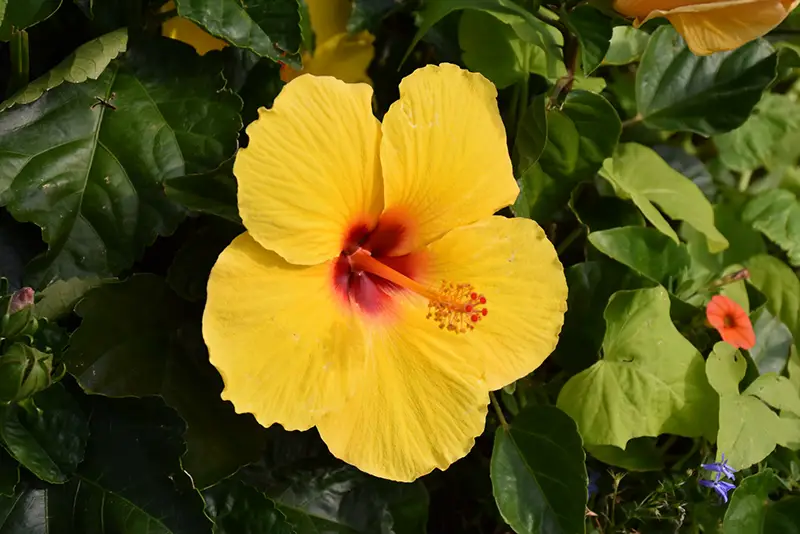
The Sunny Wind hibiscus is celebrated for its bold, golden-yellow petals with a soft orange blush near the center. Its flowers are large, typically reaching 5 to 6 inches in diameter, creating a striking display against the plant’s deep green, glossy foliage. This tropical beauty is a favorite choice for brightening gardens, patios, and balconies.
This variety thrives in full sun and prefers well-draining, fertile soil enriched with organic matter. Regular watering and monthly feeding with a balanced hibiscus fertilizer encourage continuous blooms. Light pruning after flowering helps maintain its bushy, compact shape.
Sunny Wind hibiscus grows best in USDA hardiness zones 9 to 11. In tropical climates, it can flower nearly year-round, while in cooler regions, it is often grown in containers and brought indoors during winter. It can reach 4 to 6 feet in height, making it perfect as an ornamental hedge or standalone focal point.
Chiffon Hibiscus
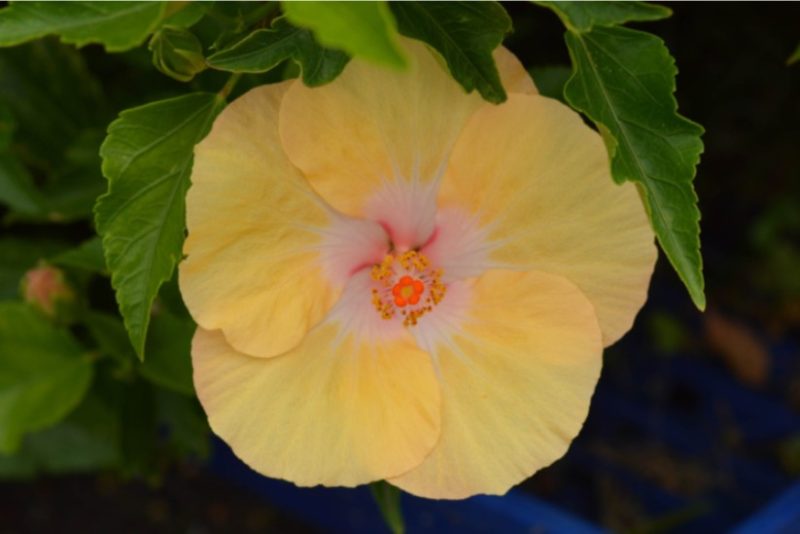
The Chiffon hibiscus stands out with its soft, buttery-yellow petals and delicately ruffled edges, giving the flowers a light, airy appearance. Some blooms may have a faint orange or red eye at the center, adding a touch of depth to its gentle color palette. Its flowers are slightly smaller than other tropical varieties, typically around 4 to 5 inches wide.
It prefers a sunny location but can tolerate partial shade, making it versatile for various garden settings. Well-draining soil and consistent moisture keep it healthy and encourage prolific flowering. Occasional pruning after blooms fade promotes new growth and maintains a rounded, compact shape.
This variety is best suited for USDA zones 9 to 11. It usually grows between 3 to 5 feet tall, making it ideal for borders, low hedges, or container planting. In colder climates, Chiffon hibiscus can be grown indoors as a decorative houseplant during the winter.
Butterball Hibiscus
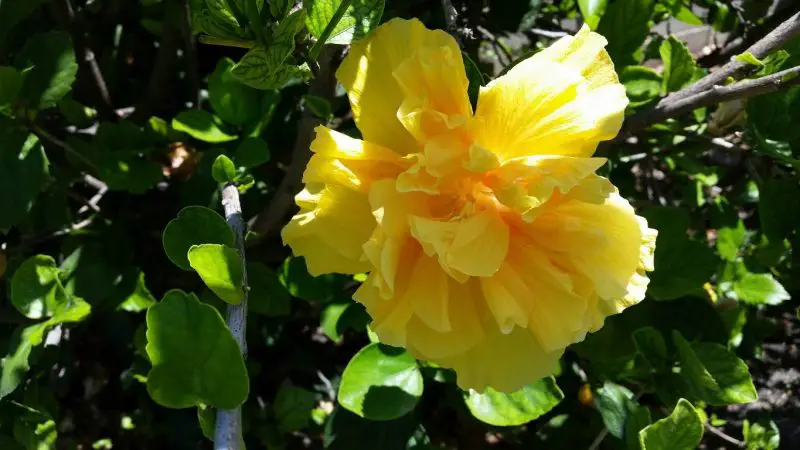
The Butterball hibiscus is loved for its rich golden-yellow petals, which sometimes feature a warm orange or red center. Its large blooms, often 5 to 6 inches across, resemble a splash of sunshine in the garden. The lush, glossy foliage provides an excellent backdrop to its vibrant flowers.
This tropical hibiscus thrives in full sun and requires nutrient-rich, well-draining soil. Regular watering is essential, especially in hot climates, but overwatering should be avoided. Fertilizing with a high-potassium hibiscus fertilizer enhances blooming and keeps the plant vigorous.
Butterball hibiscus grows well in USDA zones 9 to 11. Reaching 4 to 6 feet tall, it is ideal for use as a flowering hedge, a garden focal point, or in large patio containers. In cooler climates, it should be moved indoors or grown in greenhouses to protect it from frost.
Yellow Double Hibiscus
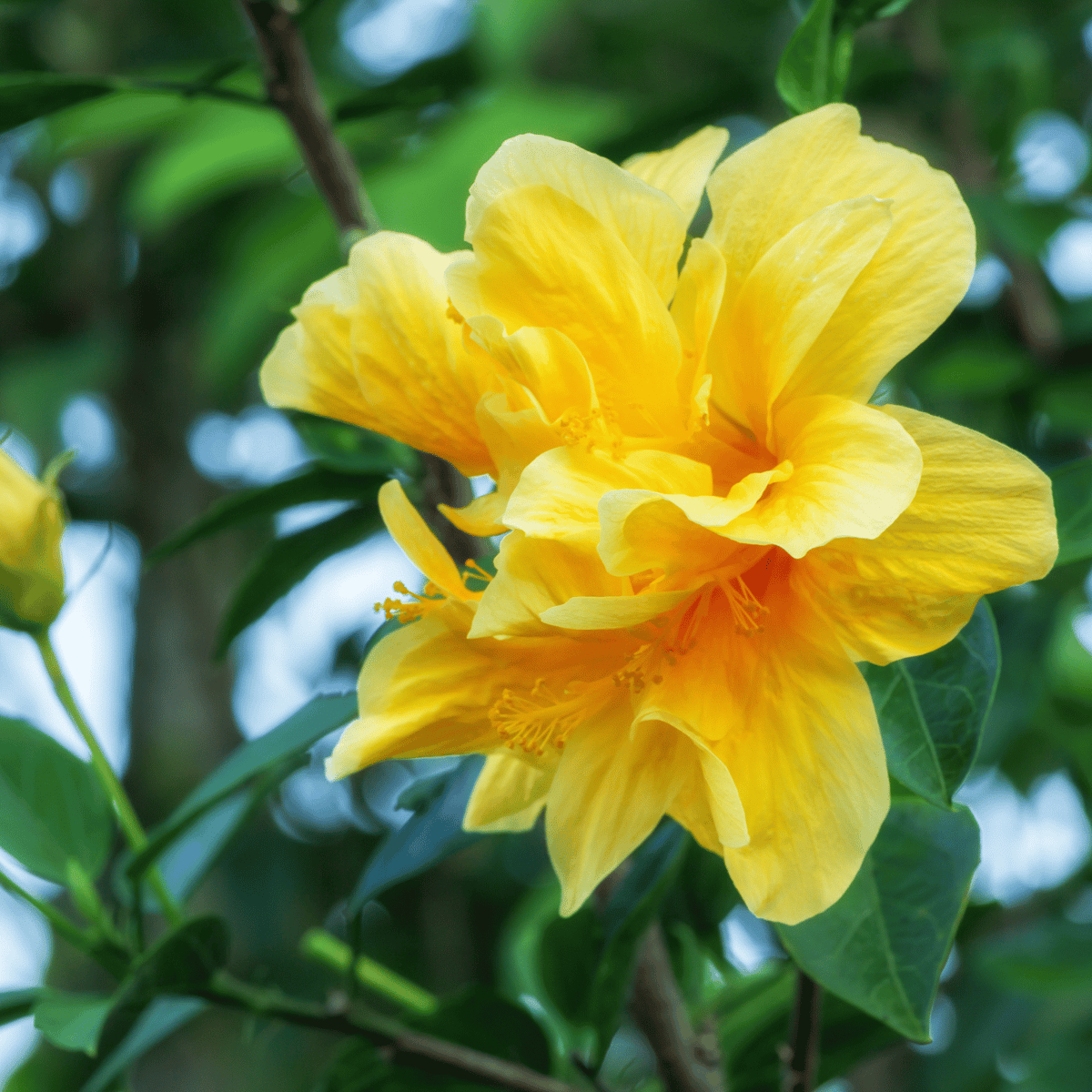
The Yellow Double hibiscus features layers of ruffled, lemon-yellow petals, creating a dense, rose-like bloom. This multi-petaled variety is highly ornamental, giving gardens a more luxurious, tropical feel. Its bright flowers contrast beautifully with the plant’s rich green leaves.
It requires full sun for maximum blooming potential and does best in fertile, well-drained soil. Regular feeding and pruning after flowering keep the plant healthy and encourage more buds to form. Consistent watering during warm months ensures vibrant flowers and lush foliage.
Yellow Double hibiscus thrives in USDA zones 9 to 11 and can reach 5 to 7 feet in height. It works beautifully as a hedge, a tropical accent plant, or even in large decorative pots. In regions with cold winters, it should be grown in containers that can be brought indoors.
El Capitolio Yellow Hibiscus
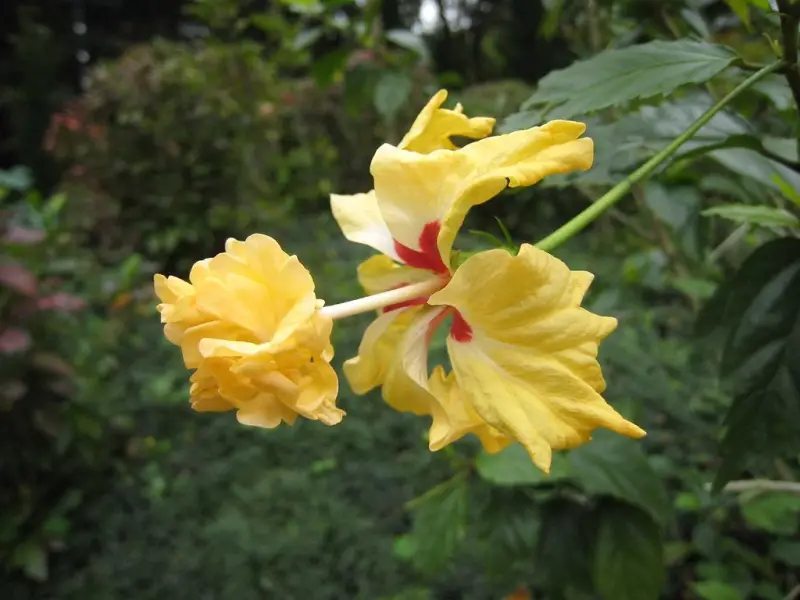
The El Capitolio Yellow hibiscus is unique for its pinwheel-like petals, giving it a dynamic, almost windmill-shaped appearance. Its golden-yellow blooms often have a faint red or orange throat, adding a touch of contrast. This distinctive shape makes it one of the most eye-catching yellow hibiscus varieties.
This variety enjoys full sun and warm, humid weather. It prefers well-draining soil and benefits from regular watering and potassium-rich fertilizer to promote heavy blooming. Light pruning helps maintain its shape and encourages new flower growth.
El Capitolio Yellow hibiscus is best suited for USDA zones 9 to 11. It can grow between 6 to 8 feet tall, making it ideal for use as a flowering screen, hedge, or a tropical garden centerpiece. In colder regions, it can be grown in containers and moved indoors during winter.
Golden Belle Hibiscus
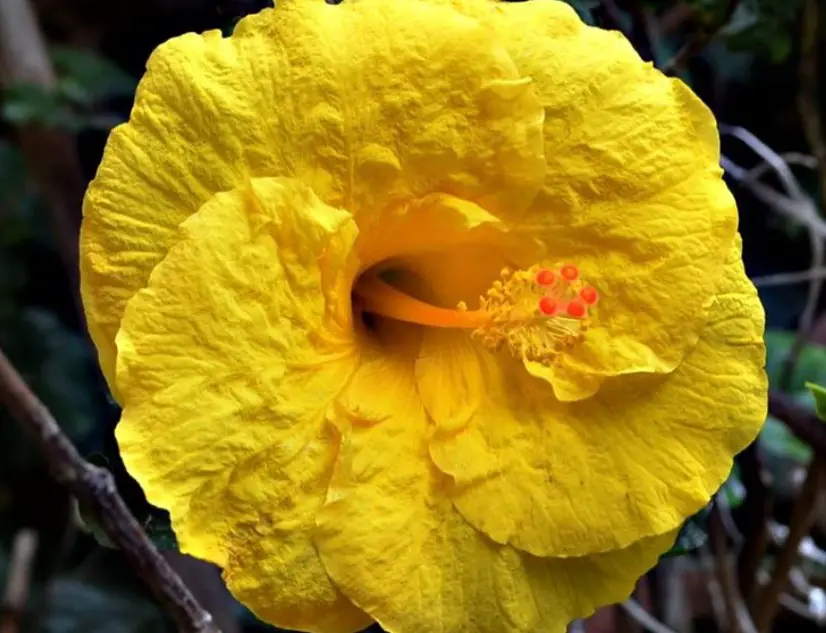
The Golden Belle hibiscus is admired for its bright, golden-yellow petals that radiate a warm glow in the garden. Its single-petaled blooms often feature a contrasting deep red or orange center, adding visual depth and attracting pollinators. The flowers can reach 5 to 6 inches across, making them a stunning tropical accent.
This variety thrives in full sun and prefers nutrient-rich, well-draining soil. Consistent watering, especially during hot months, keeps the plant healthy, but overwatering should be avoided. Fertilizing every two to three weeks with a hibiscus-specific formula helps maintain vibrant blooms.
Golden Belle hibiscus grows best in USDA zones 9 to 11. It can reach heights of 4 to 6 feet, making it suitable for borders, decorative hedges, or large containers. In cooler regions, it is often grown in pots that can be moved indoors during winter.
Haleakala Hibiscus
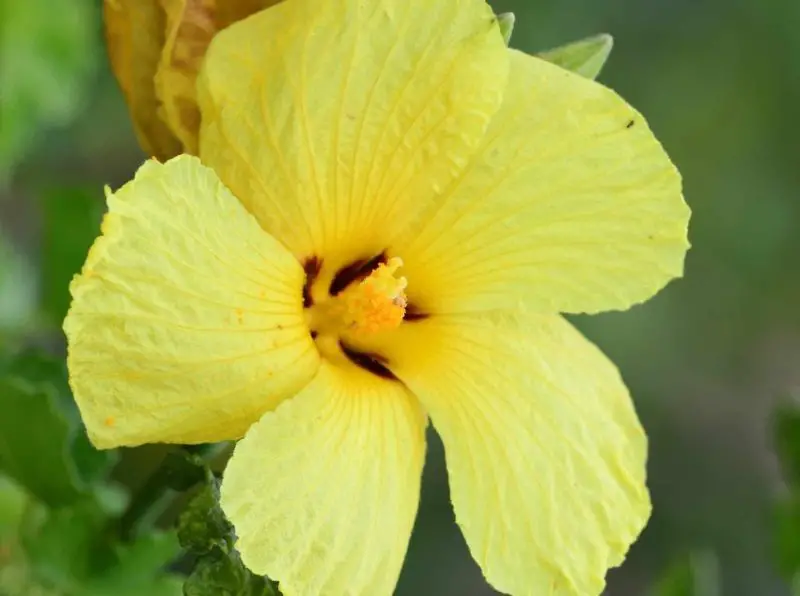
The Haleakala hibiscus is known for its vibrant yellow petals with an orange undertone and a distinct red throat. This combination of colors gives it a fiery, tropical appearance, making it a favorite among hibiscus collectors. Its blooms are medium to large, typically 5 inches wide.
It grows best in full sun with well-draining soil enriched with organic matter. Regular watering and high-potassium fertilizer encourage frequent blooming and strong growth. Light pruning after flowering helps maintain a compact shape and promotes new buds.
Haleakala hibiscus thrives in USDA hardiness zones 9 to 11. It can grow 5 to 7 feet tall, making it perfect for use as a striking focal point in tropical gardens or as part of a flowering hedge. In colder areas, it should be grown in containers and protected from frost.
Tahitian Yellow Rainbow Hibiscus
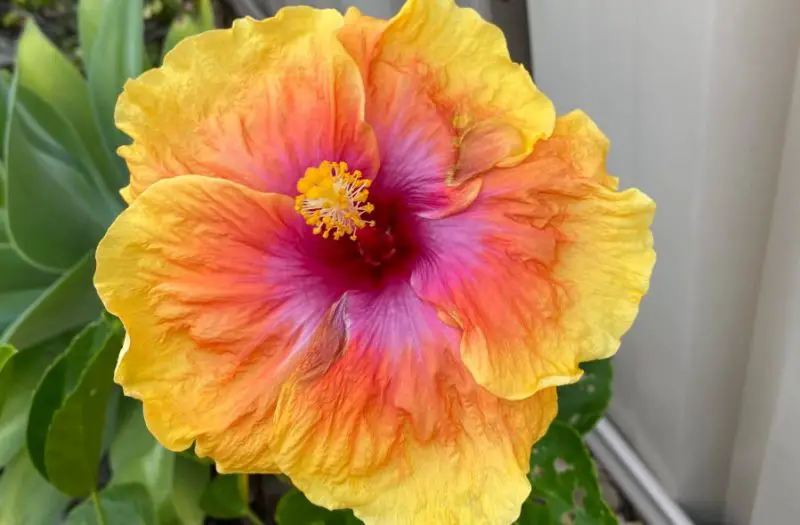
The Tahitian Yellow Rainbow hibiscus is prized for its unique color blend, with yellow petals delicately flushed with shades of pink and orange. Its ruffled edges and soft gradients give the flowers a romantic, painterly appearance. Large, showy blooms up to 7 inches wide make it an impressive ornamental plant.
This variety prefers full sun to partial shade and grows best in rich, well-draining soil. Regular watering, especially during blooming seasons, and monthly feeding with a hibiscus fertilizer help maintain its vivid colors. Occasional pruning encourages new growth and improves flower production.
Tahitian Yellow Rainbow hibiscus grows well in USDA zones 9 to 11. Reaching 4 to 6 feet in height, it is ideal for tropical borders, container planting, or as a striking specimen plant in warm climates. In cooler regions, it can be overwintered indoors.
Creole Lady Hibiscus
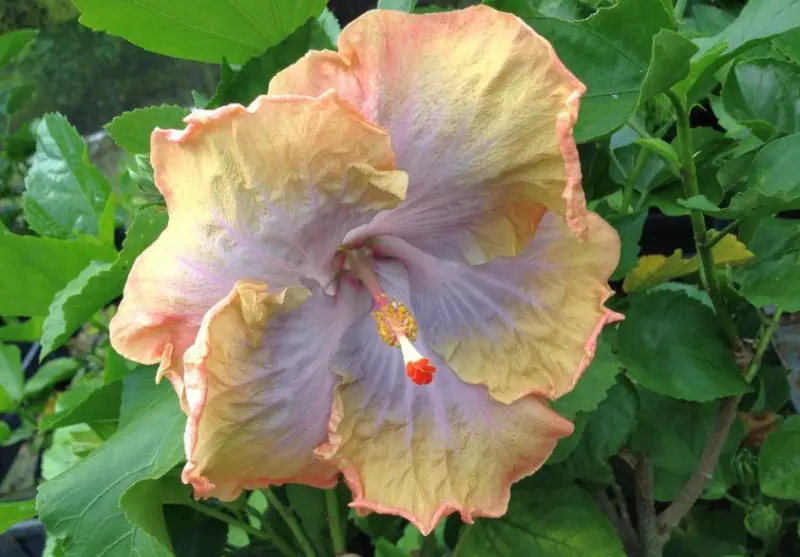
The Creole Lady hibiscus stands out with its bright, yellow-orange petals and slightly wavy edges. Its vibrant color makes it a favorite for creating a lively, tropical garden atmosphere. The blooms are typically medium to large, with some showing a subtle reddish center.
It grows best in full sun and thrives in rich, well-draining soil. Regular watering and potassium-rich fertilizer are important to support its heavy blooming. Pruning after flowers fade keeps the plant neat and encourages fresh growth.
This variety is best suited for USDA zones 9 to 11. It typically grows 4 to 6 feet tall, making it suitable for garden borders, hedges, or large decorative pots. In colder climates, it should be moved indoors during the winter.
Golden Butterfly Hibiscus
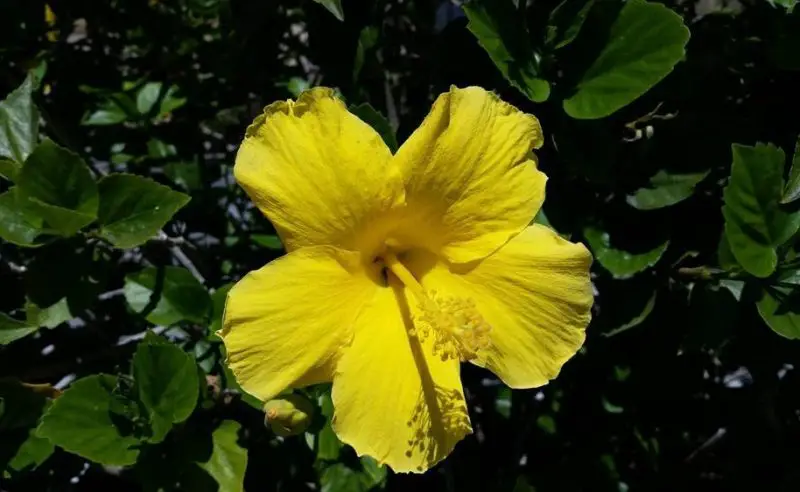
The Golden Butterfly hibiscus is named for its delicate, soft-yellow petals that resemble butterfly wings. Its blooms are airy and elegant, often with a slightly deeper yellow center that highlights their graceful appearance. This variety adds a touch of lightness and charm to tropical landscapes.
It thrives in full sun but can tolerate partial shade, making it versatile for different garden settings. Well-drained, fertile soil and regular watering keep it healthy and flowering. Light pruning after blooming encourages a fuller, bushier plant.
Golden Butterfly hibiscus is well-suited for USDA zones 9 to 11. It generally grows 3 to 5 feet tall, perfect for low hedges, container gardening, or patio decoration. In cooler regions, it can be easily grown indoors during cold months.
Tahitian Yellow Bird Hibiscus
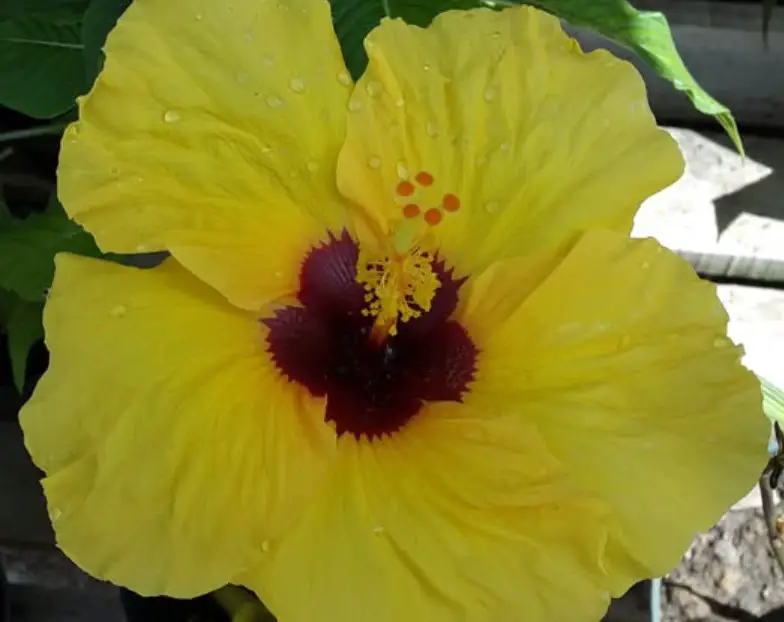
The Tahitian Yellow Bird hibiscus features large, bright yellow petals with a subtle orange glow near the center. Its bold, open flowers can reach up to 6 inches across, making it a standout in tropical gardens. The plant’s dark green foliage provides a beautiful backdrop to these cheerful blooms.
It prefers full sun and thrives in well-draining, fertile soil rich in organic matter. Regular watering and balanced fertilization help promote continuous flowering and healthy growth. Pruning after the flowering period encourages a denser, bushier form.
This hibiscus grows best in USDA zones 9 to 11. It typically reaches 4 to 6 feet tall, suitable for use as a hedge, patio specimen, or vibrant garden accent. In cooler climates, it can be container-grown and brought indoors during winter.
Hibiscus rosa-sinensis ‘Gold Medal’
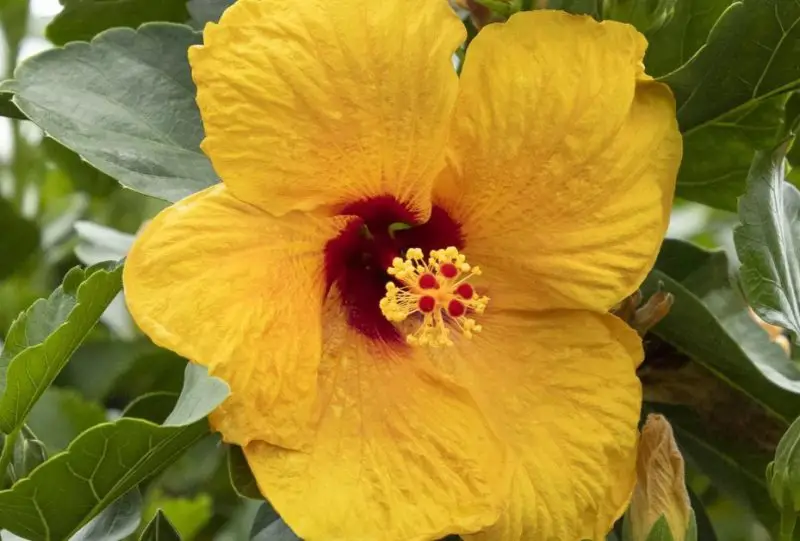
‘Gold Medal’ is a prized yellow hibiscus cultivar known for its brilliant lemon-yellow, thick petals that create a full, lush bloom. The flowers often measure 5 to 6 inches across and have a subtle red eye in the throat, adding depth to their radiant color.
This variety thrives in full sun with fertile, well-drained soil. It benefits from consistent moisture and monthly fertilizing with a high-potassium formula to support prolific blooming. Regular pruning helps maintain a compact shape and encourages new flowers.
‘Gold Medal’ hibiscus is best grown in USDA zones 9 to 11. It grows between 4 to 6 feet tall and makes an excellent choice for hedges, borders, or container planting. In cold climates, it should be protected from frost by bringing it indoors or growing in a greenhouse.
Tahitian Yellow Jack Hibiscus
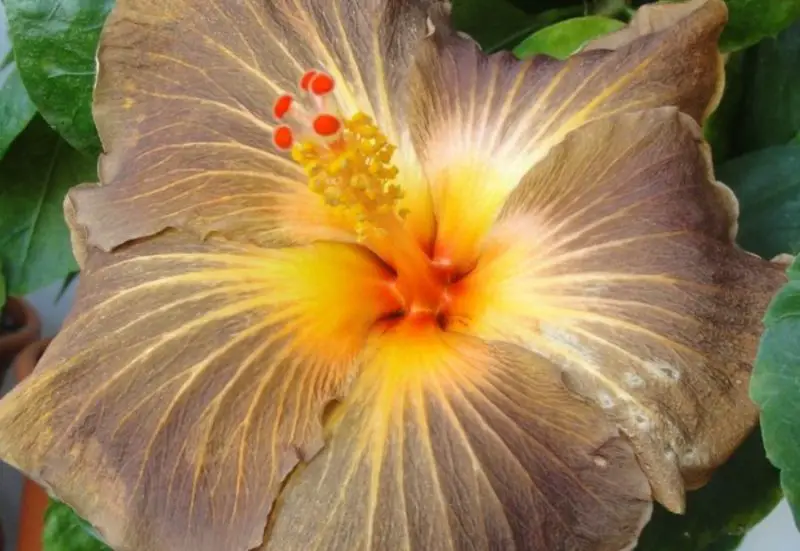
The Tahitian Yellow Jack hibiscus is notable for its deep golden-yellow petals and a rich red center. Its striking two-tone coloration gives the flowers a vibrant and exotic appearance. Blooms typically measure 5 to 6 inches across, standing out in any garden.
This variety requires full sun and well-draining soil enriched with organic matter. Consistent watering and feeding encourage strong growth and abundant flowering. Light pruning after bloom cycles promotes bushier growth and more blooms.
Tahitian Yellow Jack grows well in USDA hardiness zones 9 to 11. It can reach 5 to 7 feet in height, making it suitable for use as a tropical screen, hedge, or specimen plant. In colder regions, container growing and indoor winter care are recommended.
Sunny Wind Supreme Hibiscus
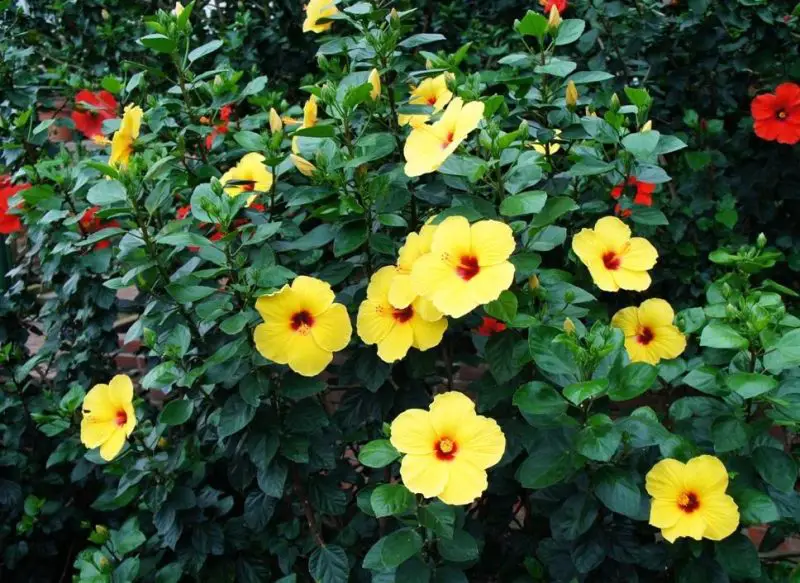
Sunny Wind Supreme is a vigorous yellow hibiscus variety with bright yellow petals that often show a subtle orange hue near the throat. The large, showy flowers can reach 6 inches or more in diameter, offering a radiant splash of color in any landscape.
It flourishes in full sun with rich, well-drained soil and requires regular watering. Fertilizing monthly with a balanced fertilizer designed for hibiscus helps maintain continuous blooms and healthy foliage. Pruning encourages a bushy growth habit.
This variety thrives in USDA zones 9 to 11 and can grow up to 6 feet tall. It is ideal as a tropical hedge, patio specimen, or border plant. During colder months, it can be grown in containers and moved indoors to avoid frost damage.
Tahitian Yellow Star Hibiscus
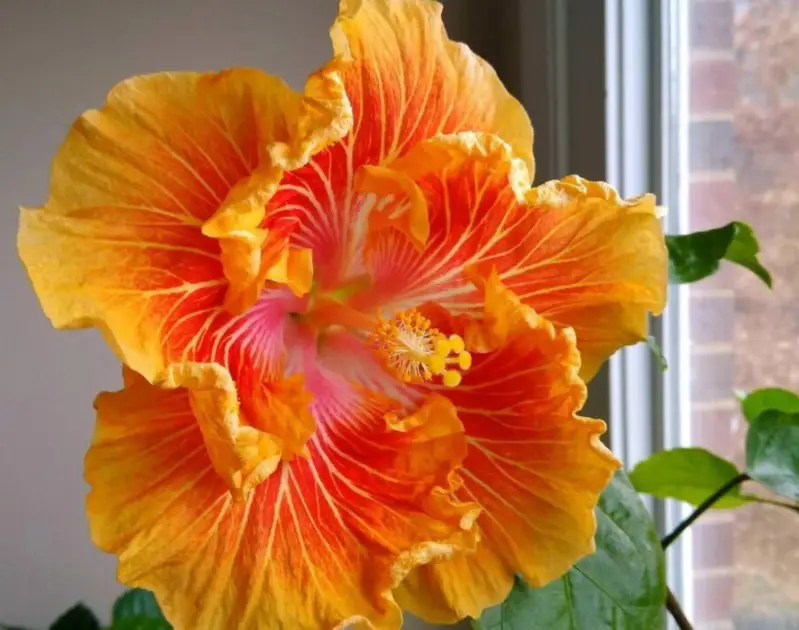
Tahitian Yellow Star hibiscus is distinguished by its bright yellow petals arranged in a star-like pattern, often with a soft orange or red center. The unique petal arrangement and vivid color make this variety highly ornamental and popular in tropical gardens.
It prefers full sun exposure and well-draining, fertile soil. Regular watering during dry spells and monthly feeding with hibiscus fertilizer encourage profuse blooming. Light pruning after flowering keeps the plant healthy and well-shaped.
This hibiscus grows well in USDA zones 9 to 11, reaching heights of 5 to 7 feet. It works well as a tropical focal point, hedge, or container plant. In areas with colder winters, it can be grown indoors or moved into protected environments.
How to Care for Yellow Hibiscus
Yellow hibiscus plants are tropical beauties that bring vibrant color and a sunny feel to any garden or container. To keep your yellow hibiscus healthy and blooming abundantly, follow these essential care tips.
Light Requirements
Yellow hibiscus thrive in full sun, which means they need at least 6 hours of direct sunlight daily. While they can tolerate partial shade, too little sun may result in fewer flowers and leggy growth. If growing indoors, place your hibiscus near a south-facing window or provide supplemental grow lights.
Soil and Drainage
Well-draining soil is crucial for yellow hibiscus health. They prefer fertile, loamy soil enriched with organic matter. Avoid heavy clay soils or spots where water pools, as soggy roots can cause rot. Adding compost or peat moss improves soil texture and nutrient content.
Watering
Yellow hibiscus like consistently moist soil but dislike sitting in water. Water the plants thoroughly when the top inch of soil feels dry, ensuring excess water drains away. During hot weather or blooming periods, increase watering frequency, but reduce it in cooler months or dormancy.
Fertilizing
To support vigorous growth and abundant blooms, feed yellow hibiscus with a high-potassium fertilizer formulated for hibiscus or flowering plants. Apply fertilizer every 2 to 4 weeks during the growing season (spring through early fall). Avoid over-fertilizing, which can lead to excessive foliage but fewer flowers.
Pruning and Maintenance
Regular pruning helps maintain a compact shape and promotes more flowers. Prune after flowering cycles, cutting back long or weak stems. Remove dead or diseased branches promptly to encourage healthy growth. Pinching tips can also encourage bushier plants.
Temperature and USDA Zones
Yellow hibiscus grow best in USDA hardiness zones 9 to 11. They prefer warm, humid climates with temperatures above 60°F (15°C). In cooler zones, grow them in containers that can be brought indoors during winter or use a greenhouse to protect from frost.
Pest and Disease Management
Watch for common pests such as aphids, whiteflies, and spider mites. Treat infestations early with insecticidal soap or neem oil. Keep plants healthy with proper watering and airflow to reduce the risk of fungal diseases like leaf spot or root rot.
Propagation
Yellow hibiscus can be propagated by softwood cuttings taken in spring or early summer. Use healthy, semi-ripe stems about 4-6 inches long, remove lower leaves, and root them in a moist growing medium. Rooting hormone and bottom heat can improve success rates.
Frequently Asked Questions (FAQs)
What sunlight does yellow hibiscus need?
Yellow hibiscus thrives in full sun, requiring at least 6 hours of direct sunlight daily for optimal blooming.
How often should I water yellow hibiscus?
Water thoroughly when the top inch of soil feels dry. Increase frequency during hot weather, reduce in cooler months.
What type of soil is best for yellow hibiscus?
Well-draining, fertile loamy soil enriched with organic matter is ideal to prevent root rot and promote growth.
How do I fertilize yellow hibiscus?
Use a high-potassium fertilizer every 2 to 4 weeks during the growing season to support healthy blooms.
Can yellow hibiscus survive cold winters?
They grow best in USDA zones 9 to 11. In colder areas, grow them in containers and bring indoors during winter.
How do I propagate yellow hibiscus?
Propagate by softwood cuttings taken in spring or early summer. Use rooting hormone and moist soil for best results.
What pests affect yellow hibiscus?
Common pests include aphids, whiteflies, and spider mites. Early treatment with insecticidal soap or neem oil helps control infestations.


